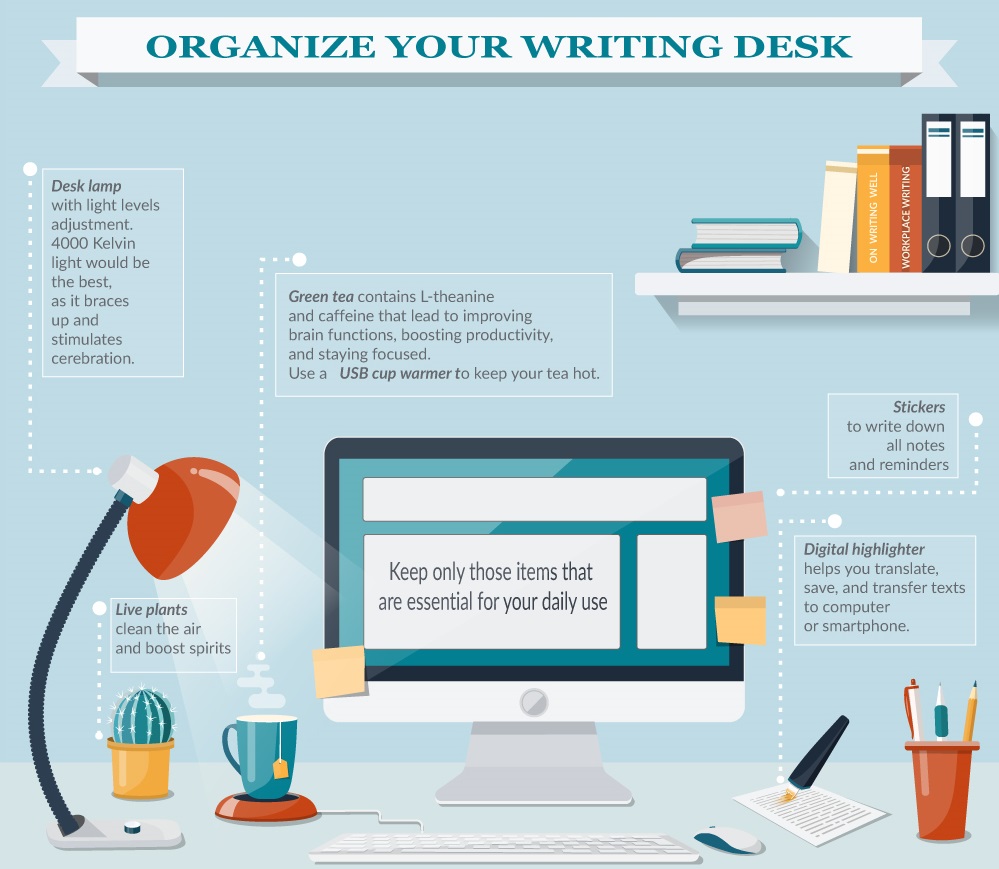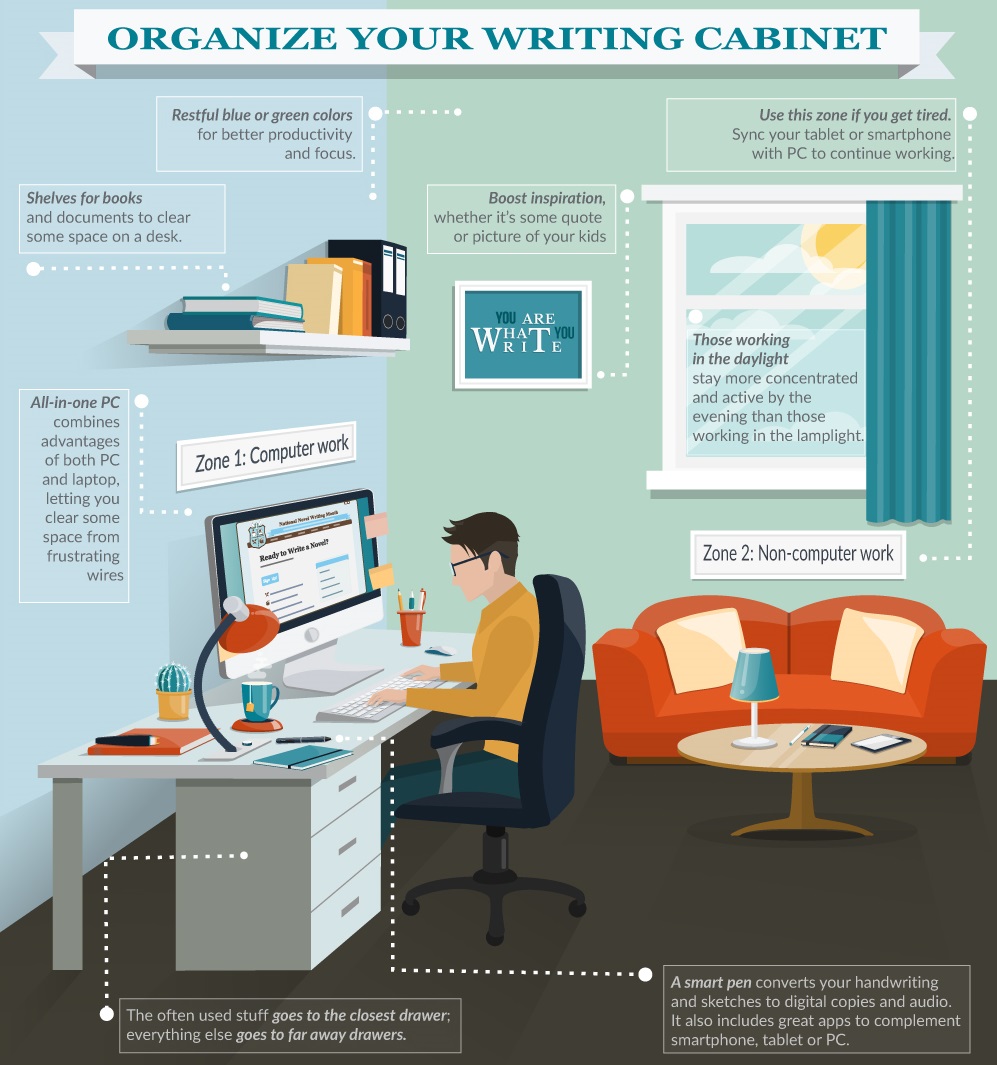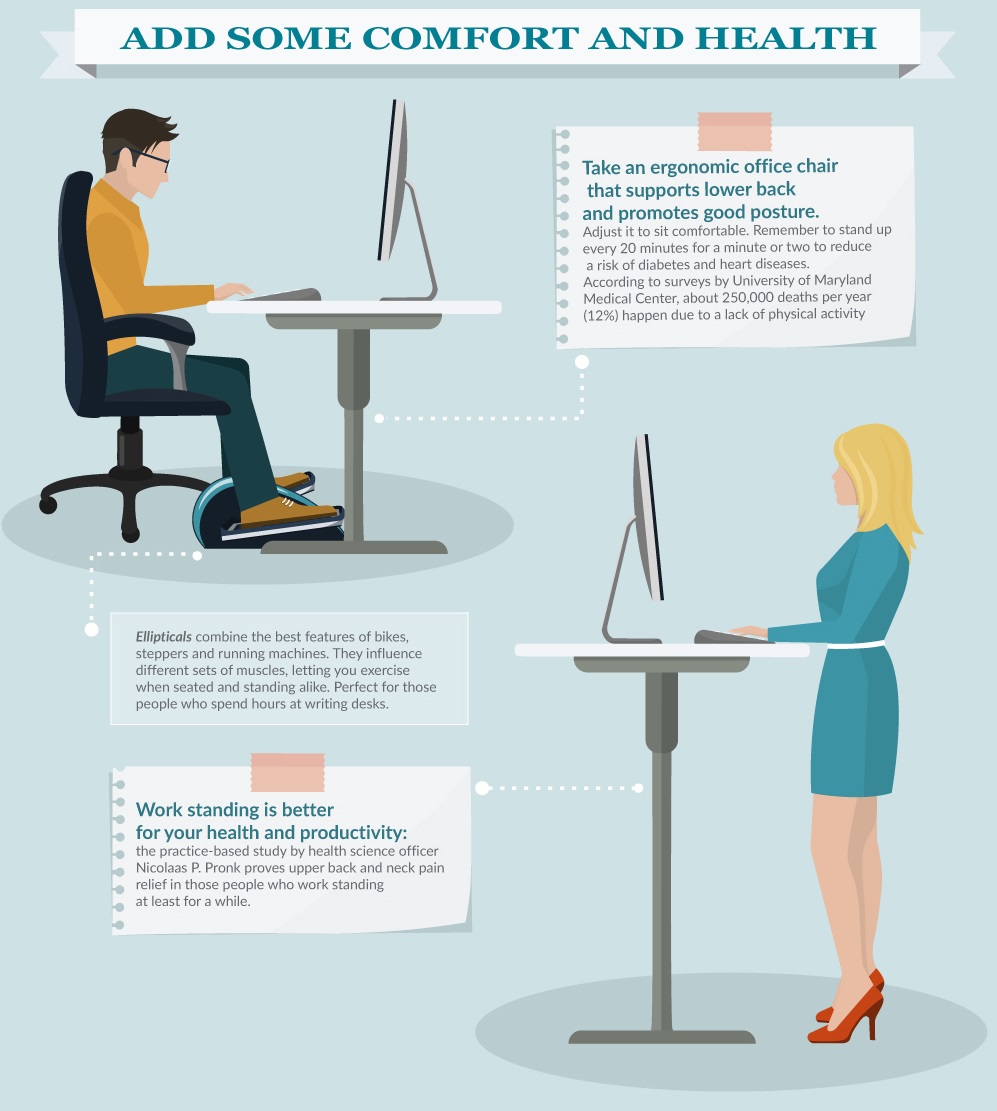A Step-by-Step Guide for Home Workplace Organization
Today’s guest post is by blogger Emily Johnson:
Proficient writers would agree that writing is not only a way to earn money but a lifestyle. We are ready to dedicate our lives to this process and work hard to improve our writing skills. We know that writing high-quality content is a must for us, so we do our best.
But what does impact our creativity, productivity, and concentration? Believe it or not, it is our workplace. And more often than not, we don’t pay attention to its organization.
Carefully planned home workplace organization can motivate you to write better and faster. So let’s take a look at a step-by-step guide that might help you organize your home workplace.
Organize Your Writing Desk
A writing desk is a place where masterpieces are born, so you need to pay attention to its placement and organization.
Table
Have you ever had problems focusing on your writing at home? The problem might be due to distractions, and dividing your attention between different things. First and foremost, try keeping your writing desk clean. It will prevent you from wasting time looking for a wanted item.
Try to form a habit of cleaning your table or desktop every day. Put books on shelves, hide papers and drafts in a cupboard or on shelves, wash dirty cups, and use containers for utensils.
When your table is clean, you might notice a productivity boost.
Lamp
Whether you work during the day or at night, you should have a lamp on or close to your table. A desk lamp provides illumination to your workplace, and it can affect your productivity.
Pick a lamp that will nicely illuminate your workplace and not strain your eyes.
Office Stuff
We use computers to write books and papers, but we still need other items in our workspace. Here are a couple of things that really help me:
- A digital highlighter. Digital highlighters are portable pen scanners that transmit handwritten text from paper to digital media and can also scan printed text. Some writers prefer writing their ideas and notes by hand, so a highlighter like this can make transferring content into a Word doc easy.
- Multicolored sticky notes. These will help differentiate tasks. For example, you can use pink stickers to write down urgent tasks, while yellow stickers could work for daily tasks. It is a good way to organize your workflow.
Live plants
It is not a secret live plants clean air. Put some plants on your writing desk to boost your spirit: cactus, aloe, a jade plant, Gerber daisies, African violets. Fragrant flowers can lend a calm and refreshing touch to your workplace.
Tea
Want to cut down on coffee? Think about drinking green tea. Green tea has been thought to boost productivity and improve brain functions, and it helps you stay focused.
Organize Your Writing Cabinet
If a person enjoys writing, he will find time to write each day. One way to help avoid writer’s block is to organize a writing cabinet. Having an organized cabinet impacts productivity too, especially if we divide our work space into zones for writing and relaxing.
Computer Zone
Your computer zone is, obviously, for working on your computer. Here is where you might write your stories, surf the Internet, communicate with clients, chat with friends on social media, and do your research.
To boost productivity, think about doing the following:
- Paint your walls blue or green. These colors help you concentrate on work. Or if you don’t want to dive into a big painting project, just make sure you have some blue or green elements in your computer zone.
- Use drawers or a filing cabinet. Drawers are practical for keeping documents, file folders, and drafts, so clear your desk of unnecessary things and put them into drawers.
- Upgrade your computer. Your work becomes easier when your computer works efficiently, so upgrade it or buy a new one if that old one is slowing or dragging you down.
This zone is aimed to help you concentrate on writing. If you feel you need a break, it’s time to shift to a no-computer zone.
No-Computer Zone
This zone is where you can relax, get inspiration, and motivate yourself to work harder. You want to take your business concerns away from this zone.
Make this zone cozy. Put in a comfortable sofa or chair, if you have room. Hang up some pictures, turn your favorite music on, have a warm, fuzzy blanket close at hand to snuggle into on a cold morning.
Your cozy place should relax and inspire you. Working hard is good, but don’t forget to rest too. Sometimes a writer’s best ideas come when resting in a comfortable place. Tony Hillerman said he spends hours lying on his couch with his eyes closed in order to plot out his novels.
Add Some Comfort and Improve Your Health
If you want to stay focused, you need to take care of your health. Being a healthy person means being active, energetic, and productive.
Sitting while You Work
Have you ever wondered why your back hurts while sitting all day long? The problem might have to do with your chair. Try to pick one that supports your lower back to prevent backache and support good posture. If you experience strain in your hands, consider an ergonomic keyboard.
Standing and Working
Some writers (and others who work at computers all day) prefer standing while they work. Standing help support the upper back, prevent neck pain, can burn extra calories, and help circulation. Some writers even set up stations on their treadmill so they can walk while they work.
If you sit at your computer all day, consider trying to work standing for one hour from time to time. If you are thinking and not actually typing, use this time to stand, stretch, and walk around.
Take a Break
Stand up every twenty minutes to walk a little. You can use this time to make some tea or call a friend. Think about taking a ten-minute break, at least, for every two hours of work. And even if you are embroiled in writing a scene or are under a tight deadline, you need to eat. So take your lunch break outside, get some fresh air, or walk your dog. When you return to your work, your mind will be more alert and your body ready to dig back in.
Conclusion
Your home workplace is where you express your creativity, so spend time considering how you want to set up this space so that your mind feels inspired and your body feels comfortable. With just the right space—who knows? You may just write that runaway best seller!
Want to print out these room diagrams for reference? Here are the links to the PDFs: Image 1, Image 2, and Image 3.
Your thoughts? What do you have in your workspace that helps you be productive? Any cool gadgets or things you hang on your walls? Share in the comments.
Emily Johnson is an avid writer and blogger. She manages the OmniPapers blog, where she shares writing ideas with students and gives them tips on college life. Follow Emily on Twitter or drop her a line on Google+.
Feature Photo Credit: Wesley Fryer via Compfight cc
















Great ideas here! I’ve clearly got some work to do!
Enjoyed this guest post, especially the infographics. I, too, write standing up at my computer and find it much better than sitting. (I also tried sitting on one of those giant balls, but that wasn’t as good as standing) There are a couple of good mentions of lights and color temperature, but two things that are not mentioned and that I swear by are: the color temperature and the illumination level of the computer screen. If your eyes get tired and/or you get headaches from hours of staring at a desktop or laptop screen, here’s something that has made a huge difference for me…
*** Change the brightness level AND the color temperature of the screen.
Most computer screens are too bright and too blue right out of the box. Dimming the screen is easy: on a Mac, just change the Brightness level (Prefs>Displays>move button to the left and uncheck “automatically adjust…”). Warming the screen’s color is more involved but it’s worth it, in my view. You make a custom “monitor profile” and the screen switches to that every time you turn on the computer. I use a third-party monitor calibrator and create different profiles like: “cosy and warm” (4000 Kelvin instead of the standard 6500 Kelvin color temperature) to yield a nice, cosy, warm screen at which to stare and write. If I need to evaluate images, I just switch to a different profile for that. I’ve created several monitor profiles and just move between them as needed. If you get headaches, this could change your life! 🙂
I like that idea about dimming the computer screen and putting in a warm hue to it. Can it be done on Windows 10?
Hi Glynis,
There’s a free app called f.lux that does a version of this. They say: “… it makes the color of your computer’s display adapt to the time of day, warm at night and like sunlight during the day.” As far as Windows 10 goes, here’s what they say in their FAQ:
“f.lux doesn’t work on Windows 10. Help?
Immediately after upgrading to Windows 10, many machines are using a basic video driver that does not work with f.lux. Windows Update will usually get a better driver (within a day) to a version that works with f.lux. In some cases this does work on its own, so we recommend that you update your drivers with the manufacturer’s latest version.”
Sounds like it doesn’t warm the screen in daytime, only at night. Not a perfect solution, but better than nothing, I guess. Search for “f.lux” or the phrase: “warming the screen in Windows 10”. Good luck!
Great advice! Just reading it makes me wanna clean up my desk and start writing again. Thank you!